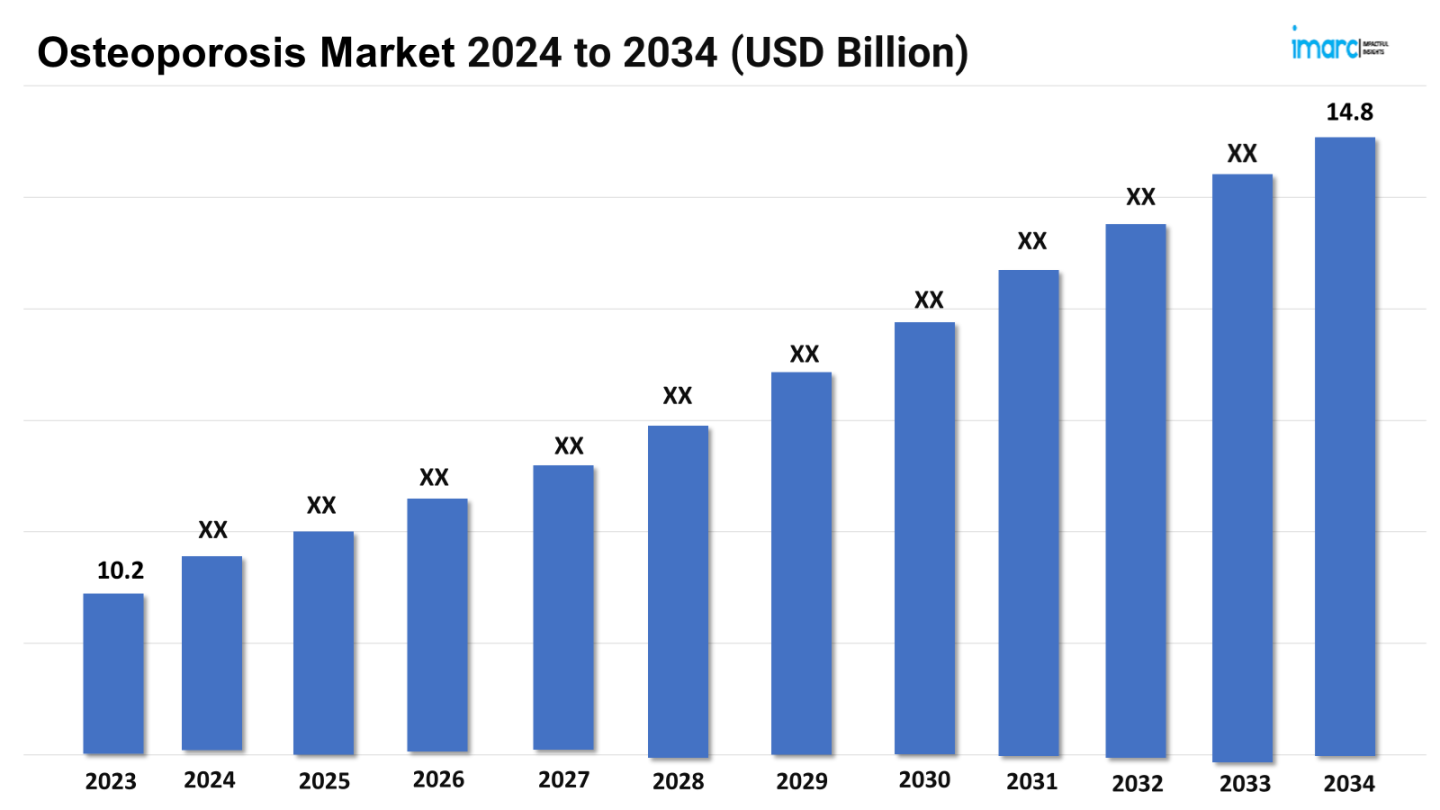Osteoporosis Market Outlook 2024-2034:
The osteoporosis market size reached a value of USD 10.2 Billion in 2023. Looking forward, the market is expected to reach USD 14.8 Billion by 2034, exhibiting a growth rate (CAGR) of 3.49% during 2024-2034. The market is driven by new drug developments and innovative treatment approaches. Additionally, advancements in diagnostic technologies, including bone density scanning and biomarkers, are enhancing early detection and personalized treatment strategies.
Biologic Therapies and Novel Drug Developments: Driving the Osteoporosis Market
The osteoporosis market is experiencing a significant transformation with the advent of biologic therapies and novel drug developments. Biologic therapies, such as romosozumab (Evenity) and denosumab (Prolia), are at the forefront of this revolution. Romosozumab, developed by Amgen and UCB, is a monoclonal antibody that works by inhibiting sclerostin, a protein that inhibits bone formation. Clinical trials have demonstrated that romosozumab significantly improves bone mineral density (BMD) and reduces the incidence of vertebral and non-vertebral fractures in postmenopausal women with osteoporosis. Denosumab, another monoclonal antibody by Amgen, targets and inhibits RANK ligand, a key regulator of bone resorption. By preventing the formation, function, and survival of osteoclasts (the cells responsible for bone breakdown), denosumab effectively increases BMD and reduces fracture risk in patients with osteoporosis. Its efficacy in reducing fractures in various patient populations, including those with glucocorticoid-induced osteoporosis and men with osteoporosis, has been well-documented. The success of these biologic therapies has not only provided new treatment options but also set a precedent for the development of next-generation osteoporosis drugs that target specific pathways involved in bone metabolism.
Request a PDF Sample Report: https://www.imarcgroup.com/osteoporosis-market/requestsample
In addition to biologics, novel drug developments in osteoporosis are focusing on optimizing treatment efficacy and safety. Anabolic agents like abaloparatide (Tymlos) and teriparatide (Forteo) stimulate bone formation and are particularly beneficial for patients with severe osteoporosis. Abaloparatide, developed by Radius Health, has shown superior efficacy in increasing BMD compared to placebo and reducing the risk of vertebral and non-vertebral fractures. Teriparatide, a synthetic form of parathyroid hormone, has been widely used to treat osteoporosis by promoting new bone growth. These novel drugs, along with advancements in drug delivery systems, such as extended-release formulations and combination therapies, are enhancing patient adherence and treatment outcomes. As research continues to evolve, the osteoporosis market is poised to see further breakthroughs that will improve the quality of life for patients suffering from this debilitating condition.
Advancements in Diagnostic Technologies: Contributing to Market Expansion
Advancements in diagnostic technologies are revolutionizing the osteoporosis market by enabling earlier detection, more precise diagnoses, and personalized treatment plans. Dual-energy X-ray absorptiometry (DXA) remains a gold standard for measuring bone mineral density (BMD), but recent innovations have enhanced its capabilities. For instance, trabecular bone score (TBS) software can now be integrated with DXA to assess bone texture and quality, providing a more comprehensive evaluation of fracture risk. High-resolution peripheral quantitative computed tomography (HR-pQCT) offers detailed 3D imaging of bone microarchitecture, allowing for a more thorough assessment of bone strength and quality beyond what BMD alone can reveal. These technologies enable clinicians to better identify individuals at high risk of fractures and tailor treatments more effectively.
The development of advanced biochemical markers is also transforming osteoporosis diagnostics. Biomarkers such as serum C-terminal telopeptide (CTX) and procollagen type 1 N-terminal propeptide (P1NP) measure bone resorption and formation rates, respectively, providing real-time insights into bone metabolism. This dynamic monitoring allows for timely adjustments in therapy, improving treatment outcomes. Genetic testing is another breakthrough, with companies like 23andMe offering tests that identify genetic variants associated with osteoporosis, aiding in risk prediction and early intervention. Additionally, artificial intelligence (AI) and machine learning (ML) are being integrated into diagnostic processes. AI algorithms can analyze imaging data to detect subtle changes in bone structure that might be missed by human eyes. For example, Zebra Medical Vision has developed AI-powered tools that automatically detect vertebral fractures from routine CT scans, facilitating early diagnosis and intervention. These advancements in diagnostic technologies are significantly enhancing the ability to detect osteoporosis early and accurately, leading to better patient management and outcomes. By integrating advanced imaging techniques, biochemical markers, genetic testing, and AI, healthcare providers can develop more personalized and effective treatment plans, ultimately reducing the burden of osteoporosis and improving the quality of life for patients.
Preventative Measures and Increased Awareness:
Preventative measures and increased awareness are pivotal trends shaping the osteoporosis market, emphasizing early intervention and education to reduce the incidence of this debilitating condition. Public health initiatives and campaigns are significantly contributing to raising awareness about osteoporosis, its risk factors, and the importance of early detection. For instance, the National Osteoporosis Foundation (NOF) in the United States runs programs like “Break Free from Osteoporosis,” which educates the public about bone health, encourages regular bone density testing, and promotes lifestyle changes to strengthen bones. Such initiatives aim to empower individuals with the knowledge to take proactive steps in preventing osteoporosis, thereby reducing the long-term burden on healthcare systems. Increased awareness has also led to a greater emphasis on lifestyle modifications as a preventive measure. Regular weight-bearing and muscle-strengthening exercises, adequate calcium and vitamin D intake, and avoiding smoking and excessive alcohol consumption are widely advocated as effective strategies to maintain bone health. Schools, workplaces, and community centers are increasingly incorporating educational sessions and fitness programs focused on bone health, aiming to instill these habits early on. For instance, the “Healthy Bones, Build Them for Life” campaign targets younger populations to emphasize the importance of bone health from an early age, thereby reducing the risk of developing osteoporosis later in life.
Healthcare providers are also playing a crucial role in preventative measures through routine screenings and personalized risk assessments. Technological advancements, such as improved bone density scanning and genetic testing, allow for earlier identification of individuals at high risk of osteoporosis. For example, tools like FRAX®, a fracture risk assessment tool developed by the World Health Organization, help clinicians predict the 10-year probability of fractures, enabling targeted prevention strategies. These efforts, combined with educational campaigns and community initiatives, are fostering a culture of prevention and early intervention in the osteoporosis market, ultimately aiming to reduce the prevalence and impact of this condition on a global scale.
Buy Full Report: https://www.imarcgroup.com/checkout?id=7845&method=587
Leading Companies in the Osteoporosis Market:
The market research report by IMARC encompasses a comprehensive analysis of the competitive landscape in the market. Across the global osteoporosis market, several leading pharmaceutical companies are at the forefront of developing innovative treatments and advancing research. Some of the major players include Amgen, AbbVie, and Roche. These companies play a crucial role in improving patient outcomes and expanding the options available for osteoporosis management.
Amgen, in collaboration with UCB, presented new data from their ongoing clinical trials at the American Society for Bone and Mineral Research (ASBMR) Annual Meeting. The latest findings demonstrate that Evenity not only significantly increases bone mineral density (BMD) but also effectively reduces the risk of fractures in postmenopausal women with osteoporosis.
Moreover, AbbVie announced the results of a large-scale study that demonstrated the long-term benefits of Alora in improving bone mineral density (BMD) and reducing the risk of fractures among postmenopausal women.
Apart from this, Roche published data from a long-term study that confirmed Boniva’s effectiveness in maintaining bone density and reducing vertebral fractures over an extended period. This study, presented at the International Osteoporosis Foundation (IOF) World Congress, showed that patients who adhered to Boniva treatment experienced significant improvements in bone health, highlighting its role as a critical therapy for osteoporosis management.
Request for customization: https://www.imarcgroup.com/request?type=report&id=7845&flag=E
Regional Analysis:
The major markets for osteoporosis include the United States, Germany, France, the United Kingdom, Italy, Spain and Japan. According to projections by IMARC, the United States has the largest patient pool for osteoporosis while also representing the biggest market for its treatment. This can be attributed to advancements in treatment options, increased awareness and preventative measures, and substantial investment in research and development.
Moreover, biological therapies such as Amgen's Prolia (denosumab) and Evenity (romosozumab) are revolutionizing the treatment landscape. Prolia is a monoclonal antibody that inhibits bone resorption, while Evenity both stimulates bone formation and decreases bone resorption, offering dual benefits.
Besides this, public health campaigns and educational initiatives have greatly increased awareness of osteoporosis and its risk factors. Organizations such as the National Osteoporosis Foundation (NOF) actively promote bone health through their "Break Free from Osteoporosis" campaign, which educates the public about the importance of bone density testing and lifestyle changes.
Key information covered in the report.
Base Year: 2023
Historical Period: 2018-2023
Market Forecast: 2024-2034
Countries Covered
- United States
- Germany
- France
- United Kingdom
- Italy
- Spain
- Japan
- Historical, current, and future epidemiology scenario
- Historical, current, and future performance of the osteoporosis market
- Historical, current, and future performance of various therapeutic categories in the market
- Sales of various drugs across the osteoporosis market
- Reimbursement scenario in the market
- In-market and pipeline drugs
This report offers a comprehensive analysis of current osteoporosis marketed drugs and late-stage pipeline drugs.
In-Market Drugs
- Drug Overview
- Mechanism of Action
- Regulatory Status
- Clinical Trial Results
- Drug Uptake and Market Performance
- Drug Overview
- Mechanism of Action
- Regulatory Status
- Clinical Trial Results
- Drug Uptake and Market Performance
IMARC Group Offer Other Reports:
Serum-Free Media Market: The global serum-free media market size reached US$ 1.3 Billion in 2023, and projected to reach US$ 2.7 Billion by 2032, exhibiting a growth rate (CAGR) of 8.19% during the forecast period from 2024 to 2032.
Antipsychotic Drugs Market: The global antipsychotic drugs market size reached US$ 16.3 Billion in 2023, and projected the 7MM to reach US$ 28.2 Billion by 2032, exhibiting a growth rate (CAGR) of 6.2% during the forecast period from 2024 to 2032.
Autologous Stem Cell and Non-Stem Cell Based Therapies Market: The global autologous stem cell and non-stem cell based therapies market size reached US$ 7.7 Billion in 2023, and projected to reach US$ 21.6 Billion by 2032, exhibiting a growth rate (CAGR) of 11.87% during the forecast period from 2024 to 2032.
Cell and Gene Therapy Market: The global cell and gene therapy market size reached US$ 18.8 Billion in 2023. , and projected to reach US$ 60.1 Billion by 2032, exhibiting a growth rate (CAGR) of 15.66% during the forecast period from 2024 to 2032.
Dermatology Devices Market: The global dermatology devices market size reached US$ 16.1 Billion in 2023, and projected to reach US$ 34.4 Billion by 2032, exhibiting a growth rate (CAGR) of 8.6% during the forecast period from 2024 to 2032.
Emergency Contraceptive Pills Market: The global emergency contraceptive pills market size reached US$ 585.9 Million in 2023, and projected to reach US$ 814.3 Million by 2032, exhibiting a growth rate (CAGR) of 3.5% during the forecast period from 2024 to 2032.
G-Protein Coupled Receptors (GPCRs) Market: The global G-protein coupled receptors (GPCRs) market size reached US$ 3.4 Billion in 2023, and projected to reach US$ 5.7 Billion by 2032, exhibiting a growth rate (CAGR) of 5.69% during the forecast period from 2024 to 2032.
Contact US
IMARC Group
134 N 4th St. Brooklyn, NY 11249, USA
Email: Sales@imarcgroup.com
Tel No:(D) +91 120 433 0800
Phone Number: - +1 631 791 1145, +91-120-433-0800


